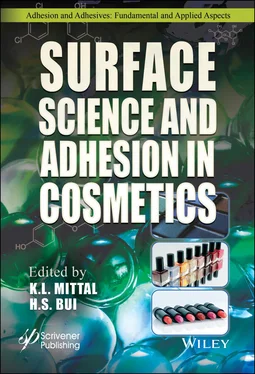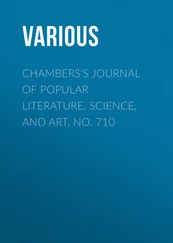3.4 UV Cure Oxygen Inhibition Issues
As mentioned earlier, oxygen inhibition issues with UV cure will result in coatings that have poor surface cure. Work done on early UV cure systems looked at the depth of penetration that ambient air had on the problem of oxygen inhibition.
It is obvious from Figure 3.8that oxygen in the uncured coating will result in less favorable cure potentially all the way down to 50 μm [5]. This potential problem resulted in development of several new techniques to solve this issue of oxygen inhibition. Some of the earliest techniques utilized paraffinic waxes that were of low density and would rise from within the coating to the surface, blocking the ambient oxygen. This technique works but the paraffinic wax needs to be ground and polished to result in a high gloss finish. Another old technique shown in Figure 3.8was the use of free radical PIs in combination with allyl ethers in the presence of oxygen to form hydroperoxides to prevent oxygen inhibition at the surface. Amines and thiol-enes will also work in mitigating oxygen inhibition. However, amines result in yellow color shades especially in light colored coatings. Thiol-ene based coatings emit strong odor before, during and after UV curing and are not a preferred chemistry for UV cured nail gels. Other method to prevent oxygen inhibition is the use of inert gases such as nitrogen, argon and carbon dioxide.
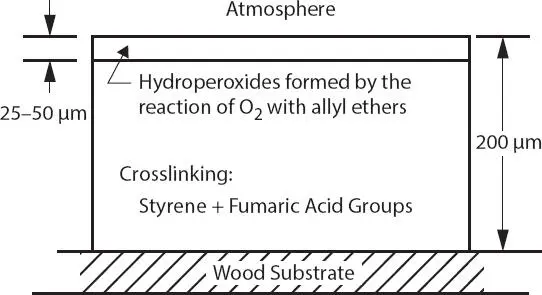
Figure 3.8 Depth of penetration by ambient oxygen in a UV cure coating. This oxygen migration into the coating is the source of oxygen inhibition by quenching the chain propagation of the free radical. The depth of oxygen penetration can be as high as 50 µm.
3.5 Special Considerations for the Use of UV Nail Gel Technology Due to Oxygen Inhibition
As was mentioned in the previous section the concept of UV nail gels has the following concerns: oxygen inhibition, low energy UV light sources, and industrial hygiene (IH).
3.5.1 UV Nail Gel Cure Units: GA-FL and LED
Oxygen inhibition is even more difficult to overcome in the UV nail gel industry since the UV cure light units liberate only very low levels of UV whether it is FL or Light Emitting Diode (LED). The power output for GA-FL units is very low. The unit is pictured in Figure 3.9.
Wattage output for the GA-FL units is as low as 40W. In addition, the newer technique for UV curing of nail gels is the use of LED units that emit an even lower level of UV energy than the GA-FL UV cure units.
Power output for these UV cure LED nail gel units ( Figure 3.10) is at 48W. Since now it has an even lower amount of UV energy to free-radically cure the coating, the oxygen inhibition issue becomes even more important.
3.5.2 UV Cure and Free Radical Oxygen Inhibition
To overcome these issues the formulator can look at the several chemical techniques to override the oxygen inhibition. As seen in Figure 3.11when the free radicals are formed (see PI reaction in Figure 3.2) oxygen in the environment quenches the PI to an unexcited non-reactive state. This quenching lowers the number of polymeric chains and thus lowers crosslinking within the system. As can be seen in the first step ( Figure 3.11) of the reaction, an oxygen-based free radical is formed which then seeks another free radical and chain terminates as shown in the second step. This classically results in an uncured coating surface [3].

Figure 3.9 Gallium-doped low-wattage long wavelength fluorescent bulb (GA-FL).
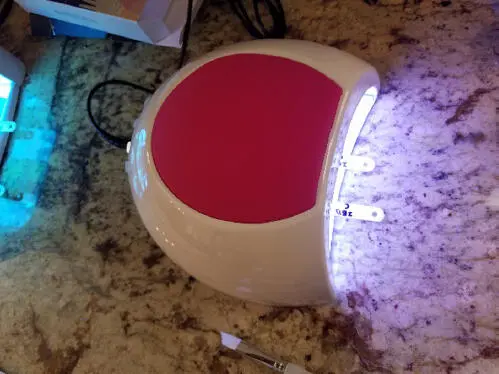
Figure 3.10 UV Cure Light Emitting Diode (LED) nail gel Unit.
3.5.3 Methods for Mitigating Oxygen Inhibition During UV Cure
Numerous techniques have been used to mitigate oxygen inhibition. As shown in Table 3.1these oxygen mitigation techniques offer several methods that work only to a certain degree [6].
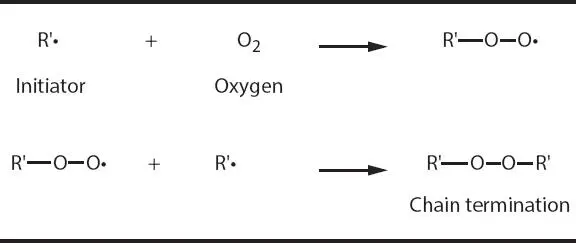
Figure 3.11 Chain termination of the free radical initiator (see PI in Figure 3.2.) by oxygen. When the free radical is formed, oxygen in the environment quenches the PI to an unexcited non-reactive state. This quenching lowers the number of polymeric chains and cross-linking within the system. As can be seen in the first step the reaction forms an oxygen based free radical which then seeks another free radical and then chain terminates as shown in the second step. This classically results in the formation of an uncured surface.
Table 3.1 Methods to Mitigate Oxygen Inhibition showing Advantages and Disadvantages. These techniques can include, but are not limited to, the following methods: uses of inert gases, waxes, coatings, increased PI concentration, increased light intensity and use of thiols, amines and ethers.
| Method |
Advantages |
Disadvantages |
| Inert Gas |
Does not adversely affect coating properties |
Expensive; difficult to implement |
| Waxes |
Inexpensive |
Affects final coating properties; time needed for migration |
| Films |
Good solution when film becomes part of product |
Cost/disposal of film when not part of product |
| Increased PI Concentration |
Easy to implement |
Increased residuals/ by-products; reduced coating properties |
| Increased Light Intensity |
May not affect coating properties |
Part of existing equipment; cost |
| Thiols |
Improved thermal resistance; reduced moisture absorption; improved adhesion |
Odor |
| Amines |
Inexpensive; possible improved adhesion |
Yellowing upon or after cure; residual odor; moisture sensitivity |
| Ethers |
Can be used in large quantities |
Affects coating properties; reduced temperature resistance; possible reduced water resistance |
Inert gases work quite well since the coating is in absence of oxygen so no oxygen inhibition can occur. In fact, electron beam curing will only work when done in an inert atmosphere. Paraffinic waxes work well also but complicate the issue with gloss since paraffinic waxes migrate to the surface and are low gloss. Two additional steps are needed to bring the UV cured coating back to its original gloss by first grinding away the wax and then buffing and polishing the surface back to a high gloss. Barrier coatings work but again add an additional step in the process and are problematic on contoured surfaces. Increasing the PI concentration is also an easy fix but it is costly and can reduce the coating properties. Also increasing the UV light intensity can help override the oxygen inhibition issues but could result in coating degradation. Thiolene based acrylate (mercapto acrylate) is currently being used in the UV cure industry but results in ‘post odor’ of the UV cured coating. Amines are also used but result in yellowing and ‘post odor’ of the UV cured coating. Ether acrylate-based chemistries are used but might result in poor performance properties of the cured coating.
Читать дальше
